7 Office Trends For Post Covid-19
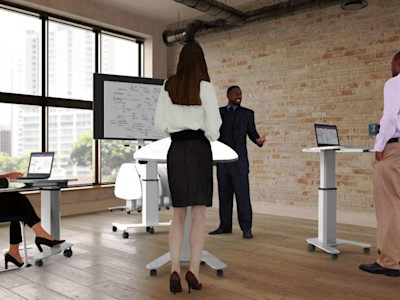
Over the last six months, the world of work has changed and patterns are beginning to emerge. The way we return to the office building, the way we use it, navigate it, and leave it behind at the end of the day...it has all shifted to a priority for safety, public health, and constant vigilance. We're now starting to see office trends post COVID-19 emerge. So, how will this affect productivity, creativity, interaction, social development, and office relationships over the next year? What do all of these workplaces have in common with their challenges and opportunities right now? If we can collectively look at what we're facing, we can make the post-COVID-19 future of work into one that is resilient with a renaissance of thinkers, doers, and leaders. The future is still fuzzy on what a post-COVID world will look like. We have identified 7 office trends of post-COVID-19 that are influencing one of the key parts of everyone's day: work. Human beings are human beings. When it comes to work and office space, they need interaction and a space to continue developing social and emotional intelligence out from behind the Zoom meeting screen. With that in mind, it’s clear that planning for the future is crucial. Humancentric design--from the floor plan to the tiniest desk plant--is taking center stage as we rethink what it means to be a human now, at this moment. The post-COVID office does and will exist and it will need post-COVID-19 office furniture along with smart, creative solutions to meet the needs of returning employees.
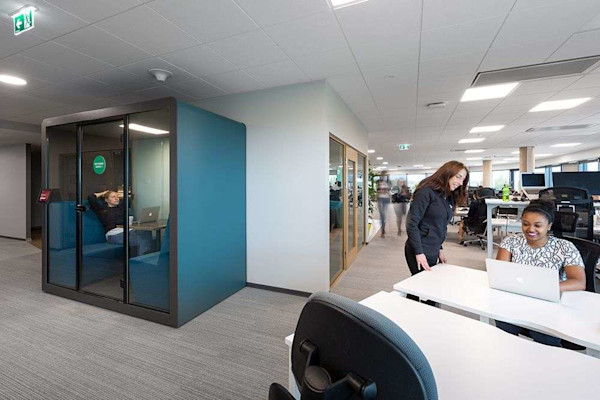
1. Social Interaction Is More Intentional.
Social distancing has shown us that, more than ever, human beings want and need to interact and socialize. It's good for our mental health and emotional wellbeing. As employees return to their office space, the nuance of social interaction is enhanced, and we're noticing that social interaction is more intentional. Your company should enforce social distancing guidelines. Incorporate furniture solutions that make distancing between coworkers possible. However, your design still needs to foster some type of face-to-face individual or small group connection. Think about your office building before the pandemic. Chances are, your employees were dealing with open office space, insufficient consideration for what employees need to stay healthy, and the lack of environmental sustainability, little to no work-life balance with a lot of background and interruptions. Underneath all of that, however, was the tie that binds: a fully present, always socializing workforce. Yes, there were interruptions, but there was also camaraderie, water cooler conversations, the quick inside joke, or video shared from a smartphone.
These interactions will need to return in some shape or form.
One of the biggest office trends post-COVID-19 is that employees have been solely existing on video conference calls. But there is a lack of collective energy that can only be recreated and harnessed into ultimate productivity when we're all in the same space. Continuing daily, weekly, or monthly check-ins should still take place even when employees return to the office. These may no longer be hour-long meetings. Instead, there will be rather quick, socially distanced updates where everyone on your team can share their wins and struggles. Social interactions need to be fostered, so the space must be intentional and thought out to ensure these interactions can still happen. General Meetings are questioned as to whether they need to be in person, and now take place in smaller groups or simply one-to-one. Departments (designers, managers, HR, finance, to name a few) may choose to become a quarantine "pod" together to protect each other and maintain a standard level of communication and socialization needed to get the job done.
Collaboration
Every successful business needs to bring brainpower together to create new ideas and produce great work. While Zoom meetings have allowed us to practice social distancing during the pandemic, when we head back to the office we’ll need modern office furniture to help us do the same. Conference tables are being reconfigured as an office trend post-COVID-19 with new, modular designs to accommodate the need to spread out in a room. For example, modern nesting tables can be moved within any space to accommodate social distancing while allowing for ergonomic functions, including height adjustability and tilting. Choosing conference tables or training tables that are uniquely designed with something like an individually-sized flower petal shape allows for quick space reconfiguration from training rows to round huddle groups. They also work in differently-sized spaces. The same goes for Employee Onboarding and Training. Whether it's a new or established staff member, social distancing is changing the way we set up training rooms and spaces. Moveable desks and stackable chairs that are easily cleaned mean that small groups can still join a training. That’s an investment that keeps employees happy and the company on track. Capture your team’s ideas on an optional built-in whiteboard surface for scheduled and impromptu brainstorming sessions, snap or upload ideas to your computer, and then clean and sanitize for the next group. Voila! Done.
Interactions
With office trends post -COVID, one thing definitely won't change but needs to be adapted: common spaces. Spaces such as Employee Lounges are being divvied up into smaller pods and hubs. This creates space for rest, relaxation, or catching up individually. Desk to Desk interactions can still happen, too! Solutions such as transparent or semi-transparent desk privacy panels and sneeze and cough protection screens not only allow you to retrofit existing modern office furniture, they allow employees to engage by sight and sound with their coworkers. These social interaction design differences may add more functionality, collaboration, and transparency to the office layout. So, where do you start? Interviewing employees on how they like to communicate with each other and observing the spaces that are potential crowd bottlenecks for social groups can help you design a new space that fosters social interaction without putting people at risk. It’s only natural that employees feel conflicted about returning to the office. There’s the desire to return to normal versus the inherent wish for safety for self and others. What's important is to design the office in a way that it feels conducive to safe, socially distant, or protected conversations and time spent together. That way, you can feel good about opening the doors to your staff. Fostering healthy social interaction will also reduce employee turnover.
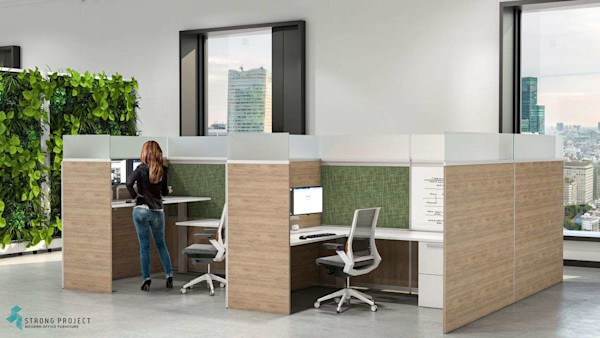
2. Personal Space Is More Defined.
Private offices and group workstations or cubicles have been completely overhauled in the last six months. They are only going to continue to evolve as the need arises. Employees will demand the sake of health, productivity, and emotional wellbeing. The second office trend post-COVID? A highly defined personal space. Over the last twenty years, private offices have slowly been replaced by open office layouts with touchdown spaces and huddle groups during the shift to open up the workplace coupled with the need to keep overhead and outfitting lean for growth. Up until January 2020, we were hot desking, working at shared tables, eating lunch in at long winding tables together. Now, with the interest in creating social distance in the office, businesses can still enjoy the perks of modern workstations (open flow, socialization, flexible arrangements) while being safe and defining personal space. Employees need personal spaces defined now more than ever, especially when it comes to the space where they spend most of their time: their own cubicle or desk.
Covid Trends
In terms of office trends post COVID-19, new private office cubicles now feature higher walls for better division and virus shielding while utilizing materials that still allow natural light and healthy airflow. The use of non-porous materials in StrongProject's post-COVID cubicles—such as laminate, acrylic, glass, and marker board—allows for quick cleaning and disinfecting of all surfaces multiple times per day. There are also add-on dividers, sliders, and walls that can quickly configure a personal space and put employees at ease. From individual offices to lighting fixtures to temperature controls and more, personalization will be prominent in the new modern workplace. We now are increasingly aware of our surroundings and we’d rather keep our things to ourselves. That’s the same for our workstation and standing desks. Office furniture solutions such as stylish post-COVID workplace cubicles offer health and safety measures in an open office space that the traditional cubicle can’t. The trick is addressing the height, width, material, and cleanability of each personal space...in addition to other environmental factors in the office. Barriers against infection are as necessary for physical health, which keeps the entire workforce running smoothly.
Modern Cubicles
This sophisticated and timeless post-COVID cubicle design provides protective screens that allow for collaboration and that crucial social interaction we crave while featuring the latest in cutting edge modern design for social distancing office furniture. Employers will want to look for a protective screen or wall height that is at least 62” so there is sufficient shielding if someone were to cough or sneeze at their desk. Side divider options should include either a desk-mounted screen or mobile screen, both of which provide shielding height at a minimum of 24” above the desktop. Look for optional interior fabric tack panels that are bleach-cleanable. If you’d rather provide your employees with 100% marker board for their interior panels, you have that option instead. New designs in personal space workstations for post-COVID include features such as...
Custom sizing for your office space
Numerous finish options including colors, textures, and fabrics
Ergonomic monitor arms
Power/USB desktop chargers
Making the Investment
If the idea of investing in full sets of workstations or sit-stand desk solutions is over your budget, consider privacy screens to create personal space for employees. Freestanding cubicle privacy screens are available in various sizes and configurations allowing you to customize the perfect post-COVID solution to work optimally with your existing workstations. Perk up your current office furniture by choosing from clear and frosted acrylic color screen options. Freestanding screens are light and moveable and come in a variety of sizes and heights to fit your existing layout. The last trick to personalization? As we transition back to the office, everyone is talking about social distancing barriers and furniture solutions that make their staff feel comfortable. However, that doesn’t mean those solutions have to be dull, because if ever there were a time to be vibrant, NOW is it. Remember, post-COVID furniture doesn't have to feel sterile or bland. You can take on social distancing with modern style and bold colors. For example, this modern curved workstation is 66-inches tall for safety and privacy and is the ideal workstation for chic productive distancing in the workplace. There are bold colors to choose from including blues, oranges, reds, greens, and more to match your business aesthetic. You don't have to afford individual private offices for every employee, but make sure you are investing in extra time to clean and disinfect between uses of shared space and making sure employees are responsible for their personal space. Clean individual meeting rooms or privacy pods after staff members meet or rest. If employees were sharing supplies or other work tools, it's time to invest in personal, labeled items for each employee. That goes for kitchen supplies, including cups and utensils. Companies who want to bring their employees back to the office need to ensure their people will be safe. And employees who are ready to return to the workplace knowing they have a "room of one's own" will be more comfortable returning to work knowing their wellness is a priority.
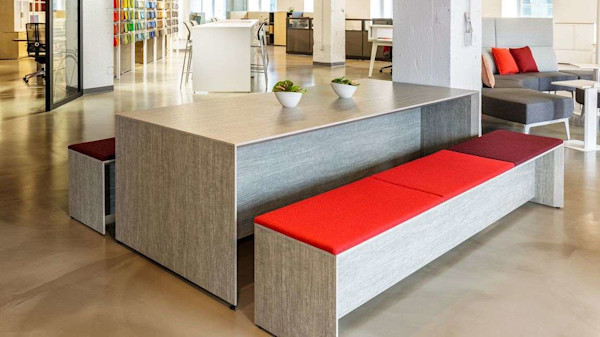
3. Office Space Is Moving Up and Stretching Out.
In addition to privacy screens, protectors, and desk dividers, what do you want to see in the post-COVID office? Acoustic pods? Private seating carved out among corners and hallway nooks? Couches or mini living spaces spread out on a single floor? Covered outdoor patio spaces? Indoor living walls overflowing with plants? Now is the time to get creative and dream big to position your company's workplace for a post-COVID world. We see your office design as being more vibrant than ever before while also becoming safer for everyone in the workplace. To accommodate the changing traffic flow of employees, floor plans will also need to look different and must be agile enough to change with your needs. For large crowds, consider one-direction traffic flow. This will help cut down on large groups getting in each other's way. Privacy furniture can support this flexibility by creating natural dividers. It can also create smaller workspaces that are safer to use alone or in small groups. You can even create virtual meetings with a coworker who is working remotely or in another part of the building. It’s not just about creating a pleasant work environment for staff; pivot spaces should be adaptable to support interaction with clients in digital presentations and face-to-face negotiations. Pods, acoustic seating, and touchdown spaces will not replace personal offices or conference rooms. They can offer your business some solutions that will give the same sense of security and privacy to their employees. You simply need to provide more of them scattered through the office in a strategic way.
Staying Connected
Remaining connected requires most people to communicate over video calls. As many people have experienced, standard conference rooms in offices were not conducive to video conferencing. Now, we can ensure our offices are more equipped to better support video conferencing and virtual gatherings for one-on-one meetings or small group brainstorms. As a result, we’ll likely see an increase in touchdown spaces. These are for employees looking to complete focused work, have private conversations, and escape for a moment. Business meetings don't need to feel cold and formal, even if we have to remain vigilant of every step we take. Post-COVID, clients visiting offices can be welcomed into a warm, inviting space that evokes the comfort of a library or sunroom. We will see a shift from large-group conference rooms to smaller spaces. and more flexible. More acoustic panels may go into place to accommodate these, or sealable meeting hubs can be installed. Focus on striking the right balance between collaboration and privacy, adding ergonomic furniture wherever possible, and creating much-needed third places for employees to disconnect and de-stress.
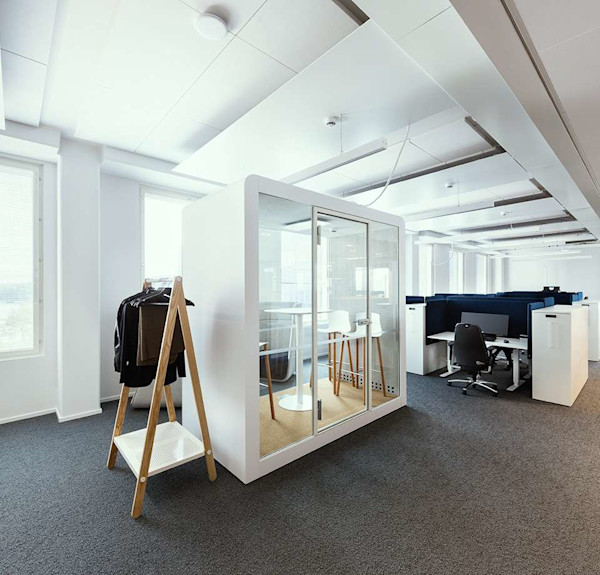
4. Sustainable Design Is Key To A Healthy Future.
It's 2020. Sustainable practices and minimize businesses’ impact on the environment. These practices are imperative to employee satisfaction, brand culture, and a triple bottom line. From using green office furniture to implementing non-toxic, recyclable, and organic materials when designing and furnishing your office space, the task of going green is more crucial than ever. Though it may seem daunting, there are easy ways to begin the process without breaking a sweat or the bank. In a post-COVID office, sustainable practices will help your staff feel more at ease knowing you care about their health and wellbeing. Sustainable design also applies to the concept of future-proofing your office for success. COVID isn't the first nor the last challenge an employer will face. Keep your employees' long-term health in mind. It's time to design or upgrade the office for optimal wellness and preventative care. That includes furniture that allows for social distancing, rest, focus, balance, ergonomics, and calm. Consider the height-adjustable cubicle, for example. The height-adjustable cubicle offers a sense of identity and ergonomic autonomy. With customizable laminate dividers, you can maintain a sense of openness. This can help you interact with colleagues and coworkers while staying healthy and safe. They also allow staff to embrace deep work and focus longer. Natural light is among the top requested employee environment features for today’s modern office, but sometimes office layouts or other circumstances get in the way.
Be Creative
Don’t just let the executives at your company have access to natural light. Instead, find creative ways to let the light in for all employees. Whether that means creating a collaborative space in your office near windows for anyone to work at or adding benches and walking paths outside the office for employees to frequent, let the light in at your modern office. Your staff might not be thinking of it on that level. When the group has the choice, they will make choices. If they have stairs OR an elevator, they will take the stairs if others do the same. If there is a quiet space to unplug, they WILL disconnect. All these proactive choices lead to improved well-being among the company. Another sustainable office feature to consider now while you're redesigning is your flooring. Bamboo, for example, has many of the properties of hardwood flooring. However, it's more ecologically friendly since it’s made from natural vegetation. Bamboo is both durable, lightweight, water-resistant, and easy to maintain and clean, all perks for when it comes to redesigning your workspace with long-term sustainability and health in mind.
5. Greenery and Airflow Are Keys to Wellness.
HVAC and air systems are all in the news now. As we enter a post-COVID world, we're painfully aware of just how easy it is to spread viruses and bacteria through air droplets. Behind smart modern office furniture, updating your air and ventilation systems is the second priority upon returning to the office. These investments, again, will pay off long-term against other common office challenges such as the flu or colds. In an office setting, clean air isn’t always available, depending on the age and status of your office building. But there are some easy fixes to this problem. Check to ensure all the air vents throughout your building are open and unblocked, and that the air filters are replaced frequently by your staff or building landlords. Adding some office plants, keeping the office clean and sanitized daily, and maintaining a healthy level balance of humidity are also a few other ways to improve air quality. But the simplest (and most expensive) method is to install an air purification and sanitation system. Other than improving the health of your employees, research shows a correlation between higher air quality and an increase in productivity. To supplement air purification systems in commercial buildings, we're seeing a resurgence of interest in living walls. These are known as "vertical gardens" that offer a refreshing green space experience. These beautiful plant-driven structures add an artistic element. They also provide all the positive feelings of being in nature. This is received by employees and clients who into your building. An added bonus: living walls act as acoustic paneling, absorbing sounds and improving focus and productivity. Consult with a local plant nursery or interior designer on installing a living wall. Make sure your greenery is located in an area where it will receive adequate sunlight. It's also important to keep it well-maintained.
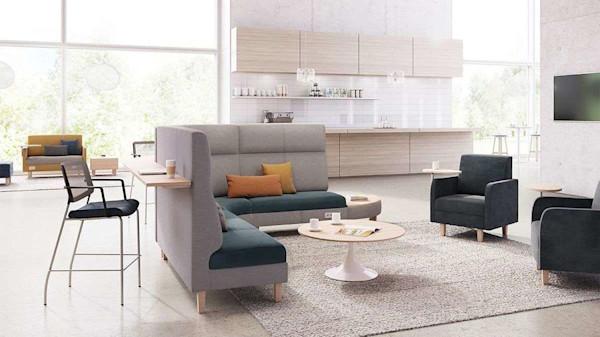
6. Employee Lounges Don't Look The Same.
We’d just gotten used to corporate offices with lavish touchdown spaces. Touted as the best way to collaborate over a cup of coffee, shared brainstorming sessions with laptops on overstuffed couches won’t be returning anytime soon. And employee lounges need to strike a balance between cleaning-friendly and warm and inviting for the near future. The secret may be in resimercial pieces. Resimercial design, a combination of residential and commercial, is a concept focused on bringing aspects of home into the office. The belief that powers resimercial furniture design is the more physically comfortable we are at the office, the more relaxed we can be with our thoughts and ourselves, unlocking higher productivity, wellness, and creativity levels. No one wants to feel like they're in a sanitized hospital room right now. Resimercial can bring in elements of warmth and relaxed living on the job. How are offices bringing this in? Sliding glass doors and partitions to allow for natural light, ambient lighting, couches, paintings, plants, and accessories. No one should feel obligated to sit in their socially distanced cubicle from 9-5 staring at the same screen. Another way to promote movement in your office is to think about an employee lounge, not as a place to take breaks, but a place to shift mindsets and reset, creating collaborative spaces around your office for employees to migrate to when they need a change of scenery.
Relaxation
When it comes to relaxation at the office, there are things you can add to reduce stress and promote wellness. Right now, it's taking people twice the amount of time on average to complete tasks, so breaks are essential. Nap pods, freestanding acoustic hubs, outfitting your breakroom with soothing teas, adding more plants around the workplace, or incorporating zen gardens in the office are effective ways to help employees feel at ease and take a break. In the past, we relied on overstuffed couches, dedicated nooks, and crowded conference rooms for team collaboration. For now, at least, we have to do better to protect others, and ourselves, from diseases. By bringing the comforts of home into the office, like soft seating options and offering multiple locations to do work, the office can become a space employees choose to escape to. Acoustic privacy furniture not only provides quiet spaces. It gives users an escape from the inevitable distractions of the office, but it also promotes productivity. They create focus as the walls block any noises from traveling outside or inside. Pods have always helped improve employee happiness and wellbeing by reducing the stresses of the office environment – this was true pre-COVID and it will remain that way afterward.
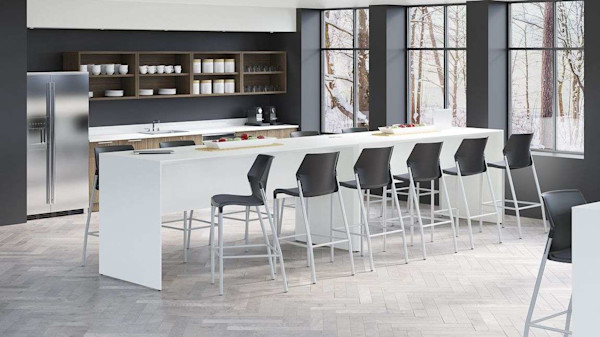
7. Office Kitchens Feel More Like Hotel Minibars.
In the office building, the employee kitchen is shifting from a place where people could gather and enjoy large communal meals and cafeteria-like dining, but in a post-COVID protocol to reduce illness through shared items, it's going the way of the hotel minibar. Think single-serving drinks, snacks, condiments, and individual cutlery. Personalized lunch bags and bento boxes. Reusable personal water bottles or disposable cups...no shared mugs or glasses anymore. It's either Bring Your Own or Ditch This Afterward. Timed visits to refrigerators and table reservations may be necessary, depending on the size of your workforce. That's not to say the old coffee pot has to be replaced with a Keurig. You can find a balance with common-sense practices. Offices that once had crowded tables may want to remove some tables to create a more socially distanced layout. Then they can install bar seating to save on square footage. Covered outdoor spaces and tables will help, too.
A Changing Office
The office isn't going away. It's simply changing. It has before and it will again. Right now, people want to see one another in a respectful, mindful way. It's the company of others. We need the brainpower and creativity. It's the thrill of breakthroughs that a shared office provides. We want to celebrate and grieve together. But most of all, we want our work to feel meaningful. The key is designing mindful, proactive, and sustainable workplaces. That allows people to lean into their work and not stress out over their workplace. These 7 post-COVID office trends show how some companies are shifting to meet those needs. If you are wondering what to do in your own unique space, ask your staff. Interviews and input can go a long way. They can bring everyone closer together and collaboratively design an improved office space everyone can feel proud of.



